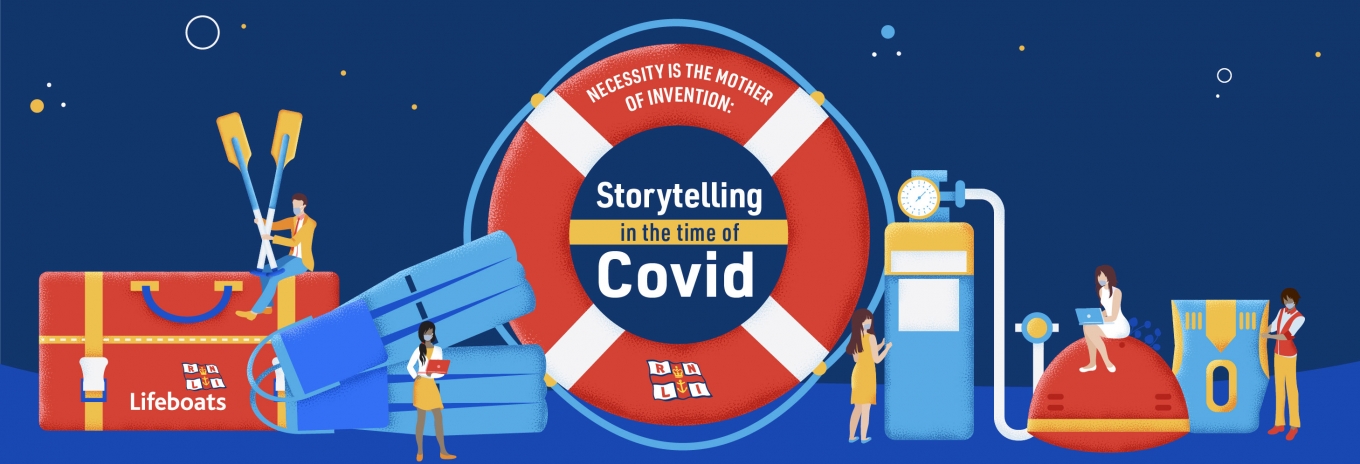Back in March, the Coronavirus lockdown created common challenges for all of us.
For organisations and communicators, it created some more unique ones.
For charities like the Royal National Lifeboat Institution (RNLI), where I work, it meant traditional income streams throttled or stopped. Events were cancelled and campaigns were pulled or radically rethought. Staff were furloughed. At the operations end, volunteers faced new rules and restrictions around training and personal protective equipment (PPE) while still being called on to save lives.
Looking out for ourselves and each other
Covid-19 also meant the RNLI’s roll-out of its seasonal lifeguard service to UK beaches was much-reduced. We quickly devised a new safety awareness campaign to encourage people to look out for themselves and one another where lifeguards couldn’t.
Our marketing and media teams also needed to adapt and approach the way we generate content and communicate with our audiences from different angles.
As one of the UK and Ireland’s larger charities, we are fortunate. Many of our volunteer lifeboat crew members wear GoPros on their helmets and our lifeboats carry fixed cameras. Our network of over 100 volunteer press officers upload the footage from rescue ‘shouts’ to a central system to be moderated by the media and operations teams ready to publish. As well as being a brilliant resource for responsive news and social media content, the footage also forms the backbone of Saving Lives at Sea, our BBC TV documentary, currently in its fifth series.
Keeping the stories coming
And as our volunteer lifeboat crews and paid lifeguards have adapted to the new ways of working to continue saving lives at sea, so the stories have kept coming, too. Summer is always our busiest time, with our lifeguards on duty alongside our lifeboats. From May onwards, as restrictions in England eased, people headed to the coast and, inevitably, some needed our lifesavers’ help.
In January, which feels a lifetime ago, I became the RNLI’s first ever case study manager. I prefer to use the term stories to case studies: they are people’s to tell, not impersonal subjects to be studied. I am privileged. I get to meet (virtually) and build relationships with people who agree to share some of the most vulnerable moments of their lives. They might have been moments from drowning, or have tragically lost a loved one. Or they could have been the person who made a split-second decision, factoring multiple dynamic risks in a chaotic environment, to save someone else’s life.
Telling your story takes courage and trust – trust we have to earn
Our duty of care to our storytelling volunteers (which is what they are – donors, too) comes first. We are mindful that the lifesaving gift of their story means giving a very personal piece of themselves.
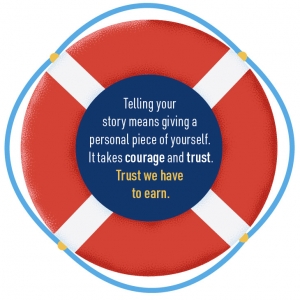 I am lucky, too, in that my job straddles various teams and disciplines. While its ‘sits’ in the media engagement (comms) team, I support, and collaborate with colleagues across social media, fundraising, marketing and internal comms, and particularly our own in-house creative team of account managers, copy editors and videographers, to find and tell stories via the gamut of paid, earned and owned channels.
I am lucky, too, in that my job straddles various teams and disciplines. While its ‘sits’ in the media engagement (comms) team, I support, and collaborate with colleagues across social media, fundraising, marketing and internal comms, and particularly our own in-house creative team of account managers, copy editors and videographers, to find and tell stories via the gamut of paid, earned and owned channels.
Covid has made collaboration, agility and creativity essential for content creation
It has been frustrating at times but also freeing. Not being able to do things the way we’ve always done them has nudged us into innovating when we may not have previously.
When I joined the RNLI in 2017 from local government comms, I was in awe of its small team of talented, in-house filmmakers and their editing suite (plus two drones!), who produce professional-quality videos. But having them also meant we didn’t need to employ the smartphone video skills I’d been practicing through necessity at the council.
In the last six months, restrictions meant we couldn’t send a team to, say, northern Scotland or the west coast of Ireland to film at a lifeboat station or in a rescue storyteller’s home.
Finding new ways to reach our people
Early on, the alternative content ideas may not have been ground-breaking, but they did mean we could bring our audience of supporters closer to our lifesavers. Our social team used Facebook Live to broadcast ‘Cuppa with the Crew’ chats with lifeboat volunteers and a virtual pub quiz hosted by a game crew member. And Liam from our regional safety team became the RNLI’s own Joe Wicks with his Water Safety Wednesday sessions (below) for home-schooling kids.
Inspiration was ‘borrowed’, too. Via a network of fellow third sector ‘story gatherers’, I heard of other charities using Zoom to capture to-camera interview pieces. After some weeks of mulling, we took the plunge.
The result was a video featuring storytellers whose own lives or those of their loved ones had been saved, telling their stories straight to our supporters.
Marking a change in style and tone
At the same time, a PR colleague in Cornwall recorded a virtual reunion via Teams between a widowed mum and the lifeguard team who saved her from a rip current, preventing her son becoming an orphan.
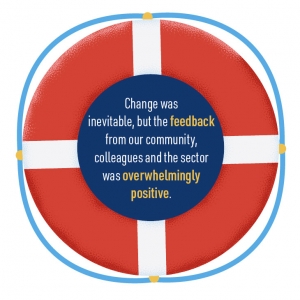 These pieces – turned around in a few days from conception to publication – marked a change in style and tone from our usual social videos. But the feedback from our community, colleagues and the sector was overwhelmingly positive.
These pieces – turned around in a few days from conception to publication – marked a change in style and tone from our usual social videos. But the feedback from our community, colleagues and the sector was overwhelmingly positive.
The learning curve has been steep
With only a single dry run, we were experimenting on the hoof and the quality was, to be honest, variable. We found Zoom produces high-quality audio but lower grade video, though better than Teams. And we hadn’t worked out how to record with just the interviewee and not the interviewer on screen. We’ve since discovered a fix in Zoom.
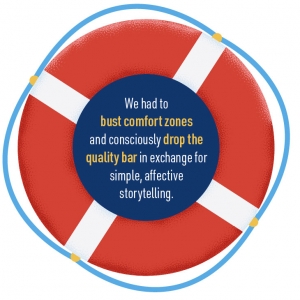 Part of the journey has been to bust comfort zones and consciously drop the quality bar in exchange for simple, affective storytelling. Online and traditional broadcast media were well ahead of comms teams in getting this. We were all used to stuttery live Skype feeds and up-nose laptop angles on the TV news even pre-Covid.
Part of the journey has been to bust comfort zones and consciously drop the quality bar in exchange for simple, affective storytelling. Online and traditional broadcast media were well ahead of comms teams in getting this. We were all used to stuttery live Skype feeds and up-nose laptop angles on the TV news even pre-Covid.
Being content rebels to our own self-imposed rules is liberating and fun
It’s also yielded results. In August, we produced our most viral video ever, using content entirely sourced from frontline responders. We collaborated with the Maritime and Coastguard Agency (MCA) who kindly shared the audio from a real 999 call by a 17-year-old called Alfie, who had become separated from his paddleboard off the North Wales coast and, in his own words, was drowning.
The power of story driving tangible outcomes
Our editor spliced the nerve-shredding conversation between a terrified teenager and a super-humanly calm call-handler with footage from the HM Coastguard helicopter and our Abersoch lifeboat to tell the story of his rescue. Alfie’s life was saved thanks to carrying a means of calling for help – his phone in a waterproof pouch – one of our key safety messages.
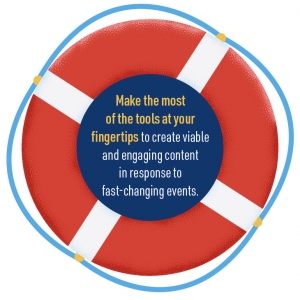 With the MCA, we used the film to promote a giveaway of 7,000 free pouches. All were snaffled within 24 hours: the power of story driving potential lifesaving. If that’s not a tangible outcome, I don’t know what is.
With the MCA, we used the film to promote a giveaway of 7,000 free pouches. All were snaffled within 24 hours: the power of story driving potential lifesaving. If that’s not a tangible outcome, I don’t know what is.
Of course, not everyone has access to helmet cams or national TV shows to share their stories. But most of us have readymade tools like Teams and Zoom, as well as our trusty smartphones, at our fingertips to create viable and engaging content in response to fast-changing events.
As ever it’s the story that counts not the way you tell it. So, go on and tell it.
Mike Carhart-Harris, Case Study Manager, RNLI
@mcarhartharris

